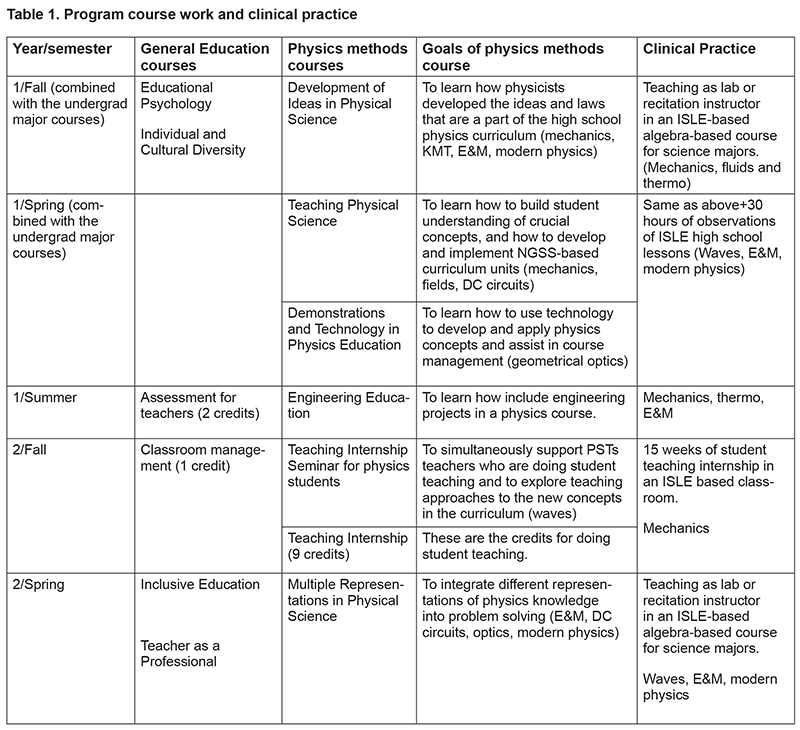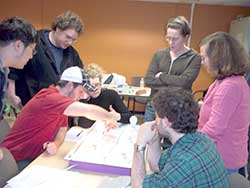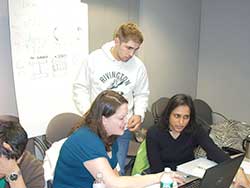Rutgers Physics Teacher Preparation Program
Eugenia Etkina, Professor of Science Education
Rutgers, The State University of New Jersey
The Rutgers physics/physical science teacher preparation program is a 45-credit, two- year master’s program that pre-service physics/physical science teachers (PSTs) can complete in five-years, or as a post baccalaureate option. In addition to earning a master’s degree, all of our program graduates also hold an undergraduate degree in physics (70%), engineering (20%), or chemistry (10%). The program, which has been in place since 2001, graduated its first teacher in 2003 and its first real cohort in 2004. Since that year the program has graduated between 5-8 teachers annually. This year it produced 10 teachers and is on track to produce 9 teachers next year. The graduates of the program form a supportive professional community that is active on Facebook (60-100 postings every month) and voluntarily meets every two to three weeks in person at Rutgers.1
The students in the program take 6 courses (18 credits) in which they learn to teach physics (as opposed to generic science methods) and have four semesters of clinical practice.2 All of the physics-related coursework and clinical experiences are inspired and united by the same learning philosophy—Investigative Science Learning Environment (ISLE).3 ISLE is a learning system that helps students learn physics through collaborative participation in reasoning processes and experimentation that is similar to the methods used by practicing physicists. ISLE students work in groups to construct their understanding of physics concepts or mathematical relations by observing carefully-selected simple physical phenomena, identifying patterns and devising multiple explanations for those patterns, and designing and conducting experiments to test their explanations—often resulting in them discovering new patterns that require new explanations. The process is similar to the differential diagnosis process used by the doctors in the television show House.
Through this method, PSTs learn how physicists discover knowledge, how to use an ISLE approach to design lessons and units, and how to assess student learning in this new environment. Using this process repeatedly not only strengthens and expands PSTs’ own physics knowledge, but also teaches them to test ideas experimentally; evaluate assumptions; represent their models in different ways; and argue, collaborate, and communicate with each other. All of these practices are also major components of the Next Generation Science Standards.4 The ISLE cycles, which include all of the concepts of a high school level physics course,5 are developed based on how people learn6 in general, and how they learn physics in particular. A wealth of physics education research (PER) provides us with the knowledge of the preconceptions that students bring into the classroom7 (these emerge as possible explanations and students have an opportunity to test them immediately), what language issues we should consider,8 how to engage students in physics practices,9 and many other important factors concerning effective physical instruction.
During the first 6 - 7 classes of each physics teaching method course, PSTs engage in ISLE activities as if they were high school students. The program coordinator then has the students reflect on what physics they would have learned from participating in that activity as a high school student, as well as what they, as aspiring teachers, learned about teaching. Following those classes, the PSTs plan and teach their own lessons (in groups of two) to their peers under careful supervision of, and with immediate feedback from, the program coordinator. Having PSTs teach to their peers (called microteaching) is similar to having airplane pilots train using flight simulators. Throughout these courses, the program coordinator does not lecture about effective teaching methods, but instead lets the PSTs observe her leading these new types of lessons, encourages them to reflect on their experiences, and then has them test their ideas during their own microteaching. In this way, the ISLE philosophy, which emphasizes that ideas emerge from observations and are tested through new experiments, is extended to learning how to teach.
In addition to their coursework, PSTs have four semesters of clinical practice. In three of these, they are lab or problem solving session instructors in an undergraduate, ISLE- based introductory physics course. During the fall semester of their second year, PSTs are placed in the classrooms of former program graduates (who also follow ISLE) for their student teaching internship. Having both the course work and the clinical practice send the PSTs coherent messages supporting the ISLE philosophy helps them become teachers who will engage their students in doing physics through continuous collaboration with each other.1 Through multiple physics teaching methods courses, the PSTs have an opportunity to learn the tools needed to teach all of the most important physics concepts (motions, forces, laws of conservation, kinetic molecular theory, electricity and magnetism, optics and modern physics), which prepares them to teach almost any physics lesson in a high school physics course. Table 1 describes the course work and clinical practice for each semester and shows what physics topics PSTs learn to teach in each course.

The program is described in detail in references 1 and 2. Anyone who is interested in the details of student recruitment, advising, or course and clinical practice design is welcome to contact the author of this paper—the creator and the sole coordinator of the Rutgers Physics Teacher Preparation Program.
Eugenia Etkina is a professor of science education at Rutgers University. She spent 13 years teaching high school physics before she earned her PhD in physics education. Since then she moved to Rutgers where she started the Rutgers physics teacher preparation program and took part in the reforms in introductory physics courses. In 2014 she received a Millikan medal for her contributions to physics education.
References
1 E. Etkina, Using early teaching experiences and a professional community to prepare pre-service teachers for every-day classroom challenges, to create habits of student-centered instruction and to prevent attrition, in Recruiting and Educating Future Physics Teachers: Case Studies and Effective Practices, edited by C. Sandifer and E. Brewe (American Physical Society, College Park, MD, 2015), 257-274.
2 For the details of the coursework and clinical practice see E. Etkina, Pedagogical content knowledge and preparation of high school physics teachers, Physical Review Special Topics Physics Education Research, 6, 020110 (2010) and reference 1.
3 E. Etkina, Millikan award lecture: Students of physics—Listeners, observers, or collaborative participants in physics scientific practices? American Journal of Physics, 83 (8), 669-679 (2015).
4 NGSS Lead States, Next Generation Science Standards: For States, By States (National Academies Press, Washington, DC, 2013).
5 For examples of using ISLE to help students learn traditional concepts see E. Etkina, M. Gentile, and A. Van Heuvelen, College Physics (Pearson, San Francisco, 2014) and for an example of experimental problem solving using ISLE approach see E. Etkina, G. Planinšič, and M. Vollmer, “A simple optics experiment to engage students in scientific inquiry,” Am. J. Phys. 81 (11), 815–822 (2013);
6 J. Zull, The Art of Changing the Brain (Stylus Publishing, Sterling, VA, 2002).
7 A. Arons, Teaching Introductory Physics, (Wiley and Sons, Inc,1997); L. C. McDermott and E. F. Redish, Resource Letter: PER-1: Physics Education Research, Am. J. Phys. 67, 755 (1999)
8 D. T. Brookes and E. Etkina, Using conceptual metaphor and functional grammar to explore how language used in physics affects student learning, Phys. Rev. ST Phys. Educ. Res. 3, 1 (2007).
9 E. Etkina, and G. Planinsic, Defining and Developing “Critical Thinking” Through Devising and Testing Multiple Explanations of the Same Phenomenon, The Physics Teacher, Vol. 53, October, 432-437 (2015).

Rutgers Pre-service teachers learning physics as students in an ISLE activity

Rutgers pre-service teacher microteaching to his classmates
Disclaimer – The articles and opinion pieces found in this issue of the APS Forum on Education Newsletter are not peer refereed and represent solely the views of the authors and not necessarily the views of the APS.
